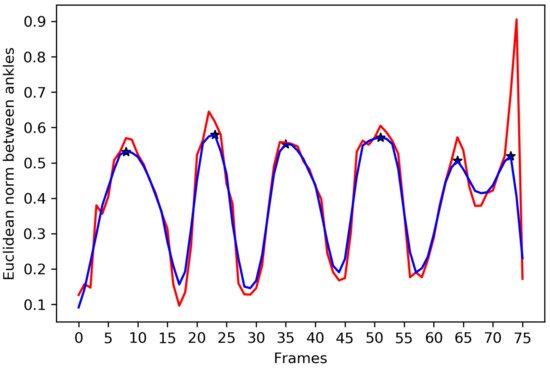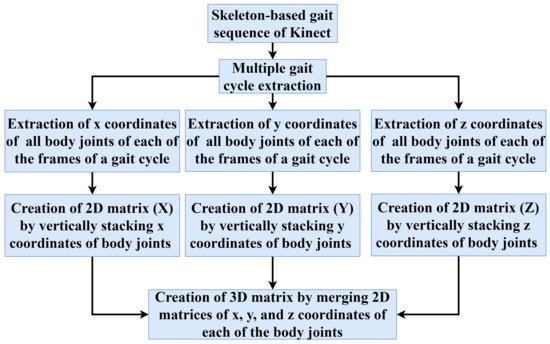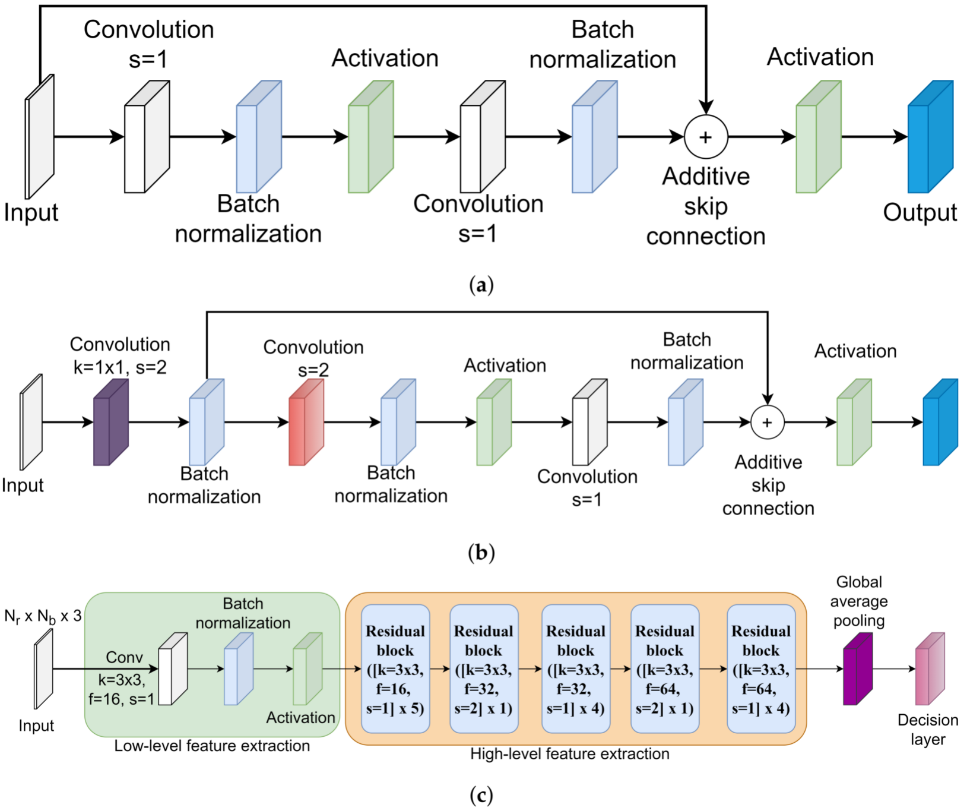Gait recognition had gained a lot of attention in various research and industrial domains. These include remote surveillance, border control, medical rehabilitation, emotion detection from posture, fall detection, and sports training. The main advantages of identifying a person by their gait include unobtrusiveness, acceptance, and low costs. Researchers proposes a convolutional neural network KinectGaitNet for Kinect-based gait recognition. The 3D coordinates of each of the body joints over the gait cycle are transformed to create a unique input representation. The proposed KinectGaitNet is trained directly using the 3D input representation without the necessity of the handcrafted features. The KinectGaitNet design allows avoiding gait cycle resampling, and the residual learning method ensures high accuracy without the degradation problem.
1. Introduction
Human gait is the repeated pattern of dynamic motions exhibited by the different body joints
[1]. Recurrent stances of heel strike, standing, and heel off are exhibited during walking
[2]. Unique characteristics extracted from the recurrent locomotion of the body joints are exploited in the biometrics for the identification of a person
[1]. The general acceptability of obtaining gait from a distance, low cost, and variety of data acquisition sensors, and in general, a high accuracy of identification of a person from a distance make gait recognition one of the most popular behavioral biometrics
[3]. Gait recognition has numerous applications, such as person identification
[4][5], human activity recognition
[6], gender recognition
[7], emotion recognition from human posture
[8], search and rescue operations
[9][10], access control
[11], medical diagnosis, treatment, and rehabilitation
[12][13].
Supervised machine learning models trained with distinctive features extracted from the biometric trait pave the way to automate the simulation of the biometric identification
[14][15]. Gait-based person identification with the help of traditional machine learning models have been studied considerably over the past decade
[16]. The accelerated pace of the development of the powerful deep learning methods has opened up unprecedented opportunities to leverage them in many domains. Domains of computer vision, computational intelligence, cognitive architectures, human–computer interaction, trustworthy decision making, defense, robotics, and biometrics benefit from the development of powerful deep learning architectures that are lightweight and versatile, and they provide high performance without overfitting. Performance of the image classification
[17], face recognition
[18], facial expression recognition
[19], person verification
[20], and others
[21][22] are enhanced, exploiting the power of deep learning. However, such approaches have been in their infancy in the biometric domain, and they have been concerned with Kinect-based person identification based on human gait
[16].
One of the first successful works that introduced deep learning neural network architecture for Kinect-based gait recognition appeared in
[23]. Aside from the deep learning approach, there have been many successful approaches devised over the past decade that facilitate the successful recognition of humans based on Kinect-based gait biometrics
[24][25][26]. These approaches had a number of deficiencies. Handcrafted classifying features were proposed for Kinect-based gait recognition in
[5][23][25][26]. The extraction of handcrafted features requires specialization in the target domain and the selection of uncorrelated distinctive features is difficult to perform. In addition, traditional machine learning methods for gait recognition relied on the computationally expensive pre-processing steps and expensive feature selection methods. A deep convolutional neural network provides new opportunities to overcome the above challenges and thus to improve recognition performance. However, when a deep convolutional network is considered for feature extraction and recognition purposes simultaneously, degradation problems may arise because the error rates in training are increased after the convergence
[27][28].
Microsoft Kinect produces a color-based depth video frame with the human skeleton from the 2D color image. The proposed architecture KinectGaitNet addresses the aforementioned challenges while overcoming degradation problems typical for deep convolutional neural networks. The main contributions of the proposed method can be outlined as follows. First, a unique 3D input representation of joint coordinates during the gait cycle is proposed. Thus, without extracting handcrafted features, the proposed input representation serves as the input of the CNN architecture for hierarchical feature extraction. Second, a new convolutional neural network architecture called KinectGaitNet based on residual learning is designed. Two types of residual learning blocks are introduced in such a way that the degradation problem is mitigated and the number of trainable parameters does not increase. Third, the KinectGaitNet architecture is being trained on variable length gait cycles, without the need of resampling to a fixed length. This is accomplished by the introduction of the global average pooling layer before the decision layer. Finally, the Adam optimization method
[29] is applied to optimize the weights of the KinectGaitNet for training the model faster and providing robustness to the model, which works with the adaptive learning rate. Two publicly available benchmark datasets, the UPCV gait dataset
[7] and Kinect Gait Biometry dataset
[24], are used to evaluate the performance of the proposed method.
2. Literature Review
The Microsoft Kinect sensor is well suited for indoor and outdoor environments because of the markerless motion analysis, easy accessibility of sensor data, and cost-effectiveness. The Kinect sensor can generate 3D skeleton data at the speed of 30 frames per second
[30]. Moreover, the extraction of the body joints tracked by the Kinect sensor shows the accuracy and precision of less than 2 mm
[31]. Clark et al.
[32] validated the applicability of the Kinect sensor for gait analysis by conducting experiments on the kinectmatic, postural, and spatiotemporal analysis.
The work on model-based gait recognition using the Kinect sensor was started by Preis et al.
[4], who introduced eleven handcrafted static and two dynamic features with Rule-based, Decision Tree (DTree), and Naïve Bayes classifiers. In the same year, temporal features of eighteen angles calculated from the selected body joints were extracted to investigate the gait attributes using the K-means clustering method
[33]. Later, Joint Relative Distance (JRD) and Joint Relative Angle (JRA) features were proposed in
[25], and the rank-level fusion technique was applied to fuse those features. Andersson and Araujo
[24] applied Multi-Layer Perceptron (MLP) architecture; however, the performance of the K-Nearest Neighbors (KNN) and Support Vector Machine (SVM) classifiers were better than that of MLP architecture. Yang et al.
[26] extracted relative distance features from selective body joints and determined their average and standard deviation over the frames of a gait cycle. Recently, by performing feature extraction from selected body joints, Sun et al.
[5] extracted static and dynamic features to train the traditional KNN classifier.
From the aforementioned related works, it is evident that prior research relied on handcrafted features to train the traditional classifiers. However, traditional classifiers can not learn hierarchical feature representation from the samples of the input data. In addition, uncorrelated handcrafted feature extraction demands target-specific knowledge. Handcrafted feature extraction also requires a feature selection step to remove features that cause a negative contribution to the performance due to correlation with other features. A first attempt at integrating deep learning with Kinect-based gait recognition was made in 2019. The researchers utilized three hidden layers to design deep neural network
[34]. Their method lacked the solution of managing different length gait sequences and thus required an additional step of the majority voting method after determining the prediction labels of each of the frames of a gait sequence. Furthermore, frame-by-frame prediction causes prediction errors because of the similarity of a particular frame with another person’s gait pattern. Another work extracted joint relative distance and joint relative angle features and determined the average and standard deviation of the handcrafted features over 30 frames
[35]. Accumulated features were trained using a convolutional neural network and optimized by the Stochastic Gradient Descent optimizer. After the re-implementation of this method, the recognition performance was below 15% on both the UPCV and Kinect Gait Biometry datasets. There are several reasons for low accuracy. First, since the CNN architecture is trained with the handcrafted features, the uniform kernel can not be used to extract hierarchical features using the CNN architecture. Second, the model suffers from overfitting. Third, the gait cycle is not considered for handcrafted features. As a result, this method is not included in the experimental section.
3. Proposed Method
The proposed methodology presents several novel contributions. The transformation approach is introduced to transform the coordinates of the body joints into a 2D matrix based on the gait cycle. Then, 2D matrices are merged to create a 3D matrix using x, y, and z coordinates. A Convolutional Neural Network (CNN) is proposed to extract a low-level to high-level distinctive hierarchical feature map and learn a person’s identification from the samples of 3D matrices. Since the input of the CNN architecture is the 3D matrix generated from the body joints, handcrafted features are avoided, and hierarchical features are extracted directly from the body joints. The proposed CNN architecture is designed in such a way that the CNN architecture can handle the variable length of the gait cycles without resampling of the 3D matrix to a fixed dimension. The residual learning
[27] blocks are introduced to design the architecture of the CNN model to mitigate the degradation problem with the reduced model parameters. The Adam optimizer is used to minimize the loss of the objective function.
There are two phases for the Kinect-based gait recognition. During the registration phase, features are extracted by the proposed convolutional neural network using residual learning from the skeleton-based gait sequences. Extracted features in different layers of the CNN model are trained and optimized during the registration phase. Optimized features are used during the identification phase. During the identification phase, unknown Kinect skeleton-based gait sequences are used. The trained CNN model is applied to the prediction of a person’s identification. The flowchart of the proposed system is shown in Figure 1.
Figure 1. Overall system flowchart of the proposed framework.
3.1. Gait Cycle Detection
A cyclic pattern of motion is observed from the body joints of the human body at the time of walking. A gait cycle is detected by tracking the Euclidean distances between two ankles. Since a walking sequence can be affected by the noise, the noise reduction filter is required to detect local maxima to determine a complete gait cycle. First, a moving average filter is applied, and a median filter is further introduced to suppress the noise in the results of the Euclidean norm between two ankles. After the noise reduction, three consecutive local maxima are detected to extract a complete gait cycle. All the local maxima of the noise reduced signal are denoted in Figure 2. The 3D coordinates of each of the body joints of a gait cycle are used to prepare the input of the proposed KinectGaitNet. Each of the gait cycles of a walking sequence exhibits unique gait attributes that need to be extracted and trained using the CNN model.
Figure 2. Euclidean norm between ankles is shown in red color. The result of noise reduction filters is shown in blue color. Local maxima is marked using the * symbol.
3.2. 3D Matrix Generation from the Body Joint Coordinates
Three-dimensional (3D) coordinates of each of the body joints over a gait cycle are used to generate a unique 3D matrix. Each of the body joints is represented using an (x,y,z) vector in the Kinect skeleton model. The number of body joints and the number of frames in a gait cycle are represented by Nb and Nf, respectively. The x coordinates of Nb body joints are extracted from each of the frames of a gait cycle. In a similar way, Nb number of y and z coordinates are retrieved. The flowchart of the 3D matrix generation process using the x, y, and z coordinates of each of the body joints over the frames of a gait cycle is shown in Figure 3. Since the number of frames in a gait cycle is not the same for every person, the value of Nf is different from person to person.
Figure 3. Flowchart of a 3D matrix generation from the body joints over the frames of a gait cycle.
3.3. Proposed Convolutional Neural Network
In this entry, a unique residual learning-based convolutional neural network is proposed for the Kinect-based gait recognition. The architecture of the proposed CNN model is shown in Figure 4. The purpose of designing the residual learning-based CNN architecture is to extract hierarchical distinctive features taking the variable dimensions of the 3D matrices as input while avoiding the degradation problem. A 3D matrix comprised of x, y, and z coordinates of each of the body joints over a gait cycle is the input for the proposed CNN architecture. If there are total N gait cycles extracted from all persons’ skeleton-based gait sequences, the input shape of the proposed CNN model becomes N × Nf × Nb × 3 where Nf is not a fixed value. The identification labels of each of the persons are converted into the one-hot encoded format. If there are total P persons’ gait sequences available in a dataset, the shape of the one-hot encoded identification label is N × P. Both the 3D matrix and one-hot encoded identification label are fed into the first layer of the CNN model.
Figure 4. Residual block ([kernel = K × K, filters = F, stride = S] × R) means residual blocks are stacked one after another R times and K × K kernel of F filters are used in the convolutional layer. Based on the value of S, one of the residual blocks of Figure 4a,b is selected. (a) Architecture of residual block when stride length is set to 1. (b) Architecture of residual block when stride length is set to 2. (c) Architecture of the KinectGaitNet.
The convolutional layer, batch normalization layer, and activation layer are the first three layers of the proposed CNN model. The spatial and temporal relationships among the body joints and the relationship among x, y, and z coordinates are extracted using the convolutional filters. Extracted features are required to be normalized to make faster convergence of the training with stability. Therefore, the batch normalization layer is subsequently included to transform the extracted features in linear fashion after the convolution layer. The scaled feature map is activated using the Rectified Linear Unit (ReLU) activation. The ReLU activation function is chosen for faster computation, monotonic derivative, reducing the likelihood of vanishing gradient, and faster training. The first three layers are responsible for extracting, scaling, and activating low-level features. Further layers of the KinectGaitNet extract high-level features based on low-level features using residual learning.
There are two types of residual blocks introduced in the proposed architecture in order to extract the hierarchical high-level feature map. The residual block takes the output of the previous layer, size of the kernel, number of filters, and stride length as an input. If the stride length is set to 1 in the residual block, the architecture of the residual block shown in Figure 4a is selected. On the other hand, if the stride length is set to 2 in the residual block, the architecture of the residual block shown in Figure 4b is applied. When the stride length is set to 1, the skip connection is introduced from the input matrix to the results of the batch normalization layer (see Figure 4a). To implement the skip connection, the merging layer of the addition type is used to add the original input matrix to the residual block and the output of the batch normalization layer. The merged results are fed into the ReLU activation layer. When the stride length is set to 2, a convolution operation is applied at first using the provided number of filters with 1 × 1 kernel. Next, the batch normalization layer is used to normalize the outputs. Consider the result of this batch normalization operation is represented as Bx1. The shortcut connection is added from Bx1 to the results of the batch normalization layer, according to Figure 4b, using the merging layer of addition type. The merged results are passed to the activation layer. The architectures of Figure 4a,b with skip connection are included in the KinectGaitNet to address the degradation problem, since the high-level feature extraction block is a deeper network.
Traditionally, the result of the final convolutional layer is flattened into the fully connected layer before the decision layer. However, a fully connected layer can not be added after the last residual block because the extracted feature map is in a variable dimension. Since the variable dimension of the 3D matrix is the input of the KinectGaitNet, the dimension of the extracted feature map after the residual block is not consistent for every gait cycle. The feature map needs to be accumulated in such a way that a consistent feature map can be generated and the accumulation process is learnable. To achieve that, researchers feed the output of the final residual block into a global average pooling layer
[36]. The global average pooling layer provides the ability of the KinectGaitNet to support the variable dimension of 3D matrices. It also significantly reduces the number of trainable parameters. Finally, the feature maps are transformed in such a way that the output of the global average pooling operation is closely related to the classification categories.
The softmax activation function is applied at the decision layer to classify persons’ identities in a multi-class gait recognition system. The categorical log loss objective function is optimized using the Adam optimizer to utilize the optimization gain of AdaGrad and RMSProp
[37]. Furthermore, the Adam optimizer provides the robustness while optimizing the hyperparameter with an adaptive learning rate.
This entry is adapted from the peer-reviewed paper 10.3390/s22072631




